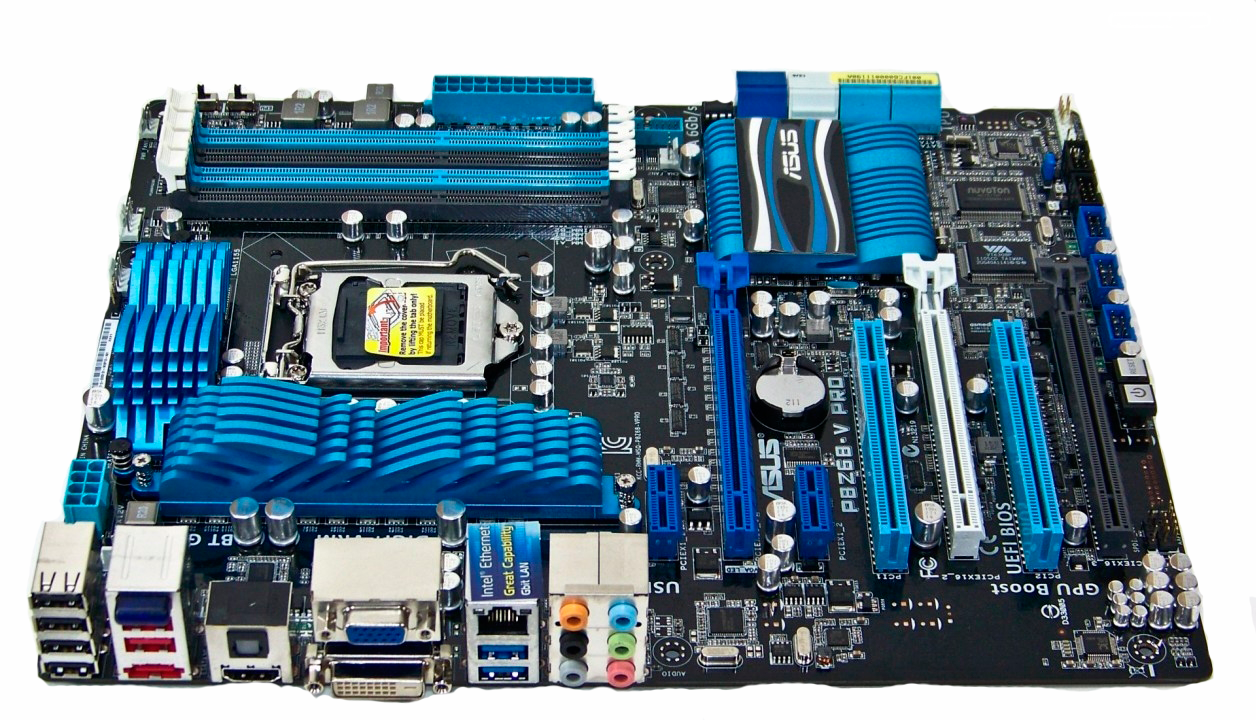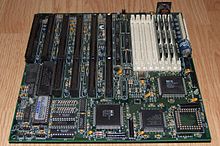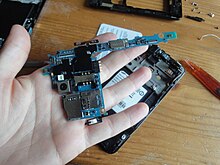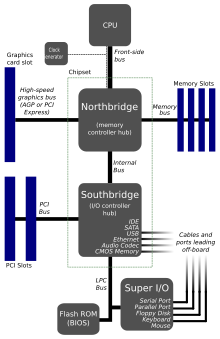motherboard
Motherboard

A motherboard (sometimes alternatively known as the mainboard, system board, baseboard, planar board or logic board,[1] or colloquially, a mobo) is the main printed circuit board (PCB) found in general purpose microcomputers and other expandable systems. It holds and allows communication between many of the crucial electronic components of a system, such as the central processing unit (CPU) and memory, and provides connectors for other peripherals. Unlike a backplane, a motherboard usually contains significant sub-systems such as the central processor, the chipset's input/output and memory controllers, interface connectors, and other components integrated for general purpose use and applications.
Motherboard specifically refers to a PCB with expansion capability and as the name suggests, this board is often referred to as the "mother" of all components attached to it, which often include peripherals, interface cards, and daughtercards: sound cards, video cards, network cards, hard drives, or other forms of persistent storage; TV tuner cards, cards providing extra USB or FireWire slots and a variety of other custom components.
Similarly, the term mainboard is applied to devices with a single board and no additional expansions or capability, such as controlling boards in laser printers, televisions, washing machines and other embedded systems with limited expansion abilities.
History[edit]
Prior to the invention of the microprocessor, a digital computer consisted of multiple printed circuit boards in a card-cage case with components connected by a backplane, a set of interconnected sockets. In very old designs, copper wires were the discrete connections between card connector pins, but printed circuit boards soon became the standard practice. The Central Processing Unit (CPU), memory, and peripherals were housed on individual printed circuit boards, which were plugged into the backplane. The ubiquitous S-100 bus of the 1970s is an example of this type of backplane system.
The most popular computers of the 1980s such as the Apple II and IBM PC had published schematic diagrams and other documentation which permitted rapid reverse-engineering and third-party replacement motherboards. Usually intended for building new computers compatible with the exemplars, many motherboards offered additional performance or other features and were used to upgrade the manufacturer's original equipment.
During the late 1980s and early 1990s, it became economical to move an increasing number of peripheral functions onto the motherboard. In the late 1980s, personal computer motherboards began to include single ICs (also called Super I/O chips) capable of supporting a set of low-speed peripherals: keyboard, mouse, floppy disk drive, serial ports, and parallel ports. By the late 1990s, many personal computer motherboards included consumer grade embedded audio, video, storage, and networking functions without the need for any expansion cards at all; higher-end systems for 3D gaming and computer graphics typically retained only the graphics card as a separate component. Business PCs, workstations, and servers were more likely to need expansion cards, either for more robust functions, or for higher speeds; those systems often had fewer embedded components.
Laptop and notebook computers that were developed in the 1990s integrated the most common peripherals. This even included motherboards with no upgradeable components, a trend that would continue as smaller systems were introduced after the turn of the century (like the tablet computer and the netbook). Memory, processors, network controllers, power source, and storage would be integrated into some systems.
Design[edit]
A motherboard provides the electrical connections by which the other components of the system communicate. Unlike a backplane, it also contains the central processing unit and hosts other subsystems and devices.
A typical desktop computer has its microprocessor, main memory, and other essential components connected to the motherboard. Other components such as external storage, controllers for video display and sound, and peripheral devices may be attached to the motherboard as plug-in cards or via cables; in modern microcomputers it is increasingly common to integrate some of these peripherals into the motherboard itself.
An important component of a motherboard is the microprocessor's supporting chipset, which provides the supporting interfaces between the CPU and the various buses and external components. This chipset determines, to an extent, the features and capabilities of the motherboard.
Modern motherboards include:
- Sockets (or slots) in which one or more microprocessors may be installed. In the case of CPUs in ball grid array packages, such as the VIA C3, the CPU is directly soldered to the motherboard.[3]
- Slots into which the system's main memory is to be installed (typically in the form of DIMM modules containing DRAMchips)
- A chipset which forms an interface between the CPU's front-side bus, main memory, and peripheral buses
- Non-volatile memory chips (usually Flash ROM in modern motherboards) containing the system's firmware or BIOS
- A clock generator which produces the system clock signal to synchronize the various components
- Slots for expansion cards (the interface to the system via the buses supported by the chipset)
- Power connectors, which receive electrical power from the computer power supply and distribute it to the CPU, chipset, main memory, and expansion cards. As of 2007, some graphics cards (e.g. GeForce 8 and Radeon R600) require more power than the motherboard can provide, and thus dedicated connectors have been introduced to attach them directly to the power supply.[4]
- Connectors for hard drives, typically SATA only. Disk drives also connect to the power supply.
Additionally, nearly all motherboards include logic and connectors to support commonly used input devices, such as USB for mouse devices and keyboards. Early personal computers such as the Apple II or IBM PC included only this minimal peripheral support on the motherboard. Occasionally video interface hardware was also integrated into the motherboard; for example, on the Apple II and rarely on IBM-compatible computers such as the IBM PC Jr. Additional peripherals such as disk controllers and serial ports were provided as expansion cards.
Given the high thermal design power of high-speed computer CPUs and components, modern motherboards nearly always include heat sinks and mounting points for fans to dissipate excess heat.
Temperature and reliability[edit]
Motherboards are generally air cooled with heat sinks often mounted on larger chips, such as the Northbridge, in modern motherboards.[5] Insufficient or improper cooling can cause damage to the internal components of the computer, or cause it to crash. Passive cooling, or a single fan mounted on the power supply, was sufficient for many desktop computer CPU's until the late 1990s; since then, most have required CPU fans mounted on their heat sinks, due to rising clock speeds and power consumption. Most motherboards have connectors for additional case fans and integrated temperature sensors to detect motherboard and CPU temperatures and controllable fan connectors which the BIOS or operating system can use to regulate fan speed.[6] Alternatively computers can use a water cooling system instead of many fans.
Some small form factor computers and home theater PCs designed for quiet and energy-efficient operation boast fan-less designs. This typically requires the use of a low-power CPU, as well as careful layout of the motherboard and other components to allow for heat sink placement.
A 2003 study found that some spurious computer crashes and general reliability issues, ranging from screen image distortions to I/O read/write errors, can be attributed not to software or peripheral hardware but to aging capacitors on PC motherboards.[7] Ultimately this was shown to be the result of a faulty electrolyte formulation,[8] an issue termed capacitor plague.
Standard motherboards use electrolytic capacitors to filter the DC power distributed around the board. These capacitors age at a temperature-dependent rate, as their water based electrolytes slowly evaporate. This can lead to loss of capacitance and subsequent motherboard malfunctions due to voltage instabilities. While most capacitors are rated for 2000 hours of operation at 105 °C (221 °F),[9] their expected design life roughly doubles for every 10 °C (18 °F) below this. At 65 °C (149 °F) a lifetime of 3 to 4 years can be expected. However, many manufacturers deliver substandard capacitors,[10] which significantly reduce life expectancy. Inadequate case cooling and elevated temperatures around the CPU socket exacerbate this problem. With top blowers, the motherboard components can be kept under 95 °C (203 °F), effectively doubling the motherboard lifetime.
Mid-range and high-end motherboards on the other hand use solid capacitors exclusively. For every 10 °C less, their average lifespan is multiplied approximately by three, resulting in a 6-times higher lifetime expectancy at 65 °C (149 °F).[11] These capacitors may be rated for 5000, 10000 or 12000 hours of operation at 105 °C (221 °F), extending the projected lifetime in comparison with standard solid capacitors.
CPU sockets[edit]
A CPU socket (central processing unit) or slot is an electrical component that attaches to a Printed Circuit Board (PCB) and is designed to house a CPU (also called a microprocessor). It is a special type of integrated circuit socket designed for very high pin counts. A CPU socket provides many functions, including a physical structure to support the CPU, support for a heat sink, facilitating replacement (as well as reducing cost), and most importantly, forming an electrical interface both with the CPU and the PCB. CPU sockets on the motherboard can most often be found in most desktop and server computers (laptops typically use surface mount CPUs), particularly those based on the Intel x86 architecture. A CPU socket type and motherboard chipset must support the CPU series and speed.
Integrated peripherals[edit]
With the steadily declining costs and size of integrated circuits, it is now possible to include support for many peripherals on the motherboard. By combining many functions on one PCB, the physical size and total cost of the system may be reduced; highly integrated motherboards are thus especially popular in small form factor and budget computers.
- Disk controllers for a floppy disk drive, up to 2 PATA drives, and up to 6 SATA drives (including RAID 0/1 support)
- integrated graphics controller supporting 2D and 3D graphics, with VGA and TV output
- integrated sound card supporting 8-channel (7.1) audio and S/PDIF output
- Fast Ethernet network controller for 10/100 Mbit networking
- USB 2.0 controller supporting up to 12 USB ports
- IrDA controller for infrared data communication (e.g. with an IrDA-enabled cellular phone or printer)
- Temperature, voltage, and fan-speed sensors that allow software to monitor the health of computer components.
motherboard
![motherboard]() Reviewed by moviebuzz
on
August 03, 2018
Rating:
Reviewed by moviebuzz
on
August 03, 2018
Rating:










No comments: